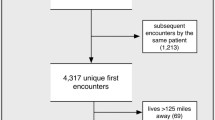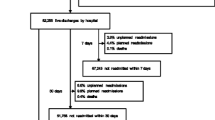Abstract
Hospital readmission has become a critical metric of quality and cost of healthcare. Medicare anticipates that nearly $17 billion is paid out on the 20 % of patients who are readmitted within 30 days of discharge. Although several interventions such as transition care management have been practiced in recent years, the effectiveness and sustainability depends on how well they can identify patients at high risk of rehospitalization. Based on the literature, most current risk prediction models fail to reach an acceptable accuracy level; none of them considers patient’s history of readmission and impacts of patient attribute changes over time; and they often do not discriminate between planned and unnecessary readmissions. Tackling such drawbacks, we develop a new readmission metric based on administrative data that can identify potentially avoidable readmissions from all other types of readmission. We further propose a tree-based classification method to estimate the predicted probability of readmission that can directly incorporate patient’s history of readmission and risk factors changes over time. The proposed methods are validated with 2011–12 Veterans Health Administration data from inpatients hospitalized for heart failure, acute myocardial infarction, pneumonia, or chronic obstructive pulmonary disease in the State of Michigan. Results shows improved discrimination power compared to the literature (c-statistics >80 %) and good calibration.




Similar content being viewed by others
References
Chassin MR, Loeb JM, Schmaltz SP, Wachter RM (2010) Accountability measures—using measurement to promote quality improvement. N Engl J Med 363(7):683–688
Jencks SF, Williams MV, Coleman EA (2009) Rehospitalizations among patients in the Medicare fee-for-service program. N Engl J Med 360(14):1418–1428
Medicare Payment Advisory Commission (2007) Report to the Congress: Promoting greater efficiency in Medicare. Medicare Payment Advisory Commission (MedPAC)
Tsai TC, Joynt KE, Orav EJ, Gawande AA, Jha AK (2013) Variation in surgical-readmission rates and quality of hospital care. N Engl J Med 369(12):1134–1142
Westert GP, Lagoe RJ, Keskimäki I, Leyland A, Murphy M (2002) An international study of hospital readmissions and related utilization in Europe and the USA. Health Policy 61(3):269–278
Hansen LO, Young RS, Hinami K, Leung A, Williams MV (2011) Interventions to reduce 30-day rehospitalization: a systematic review. Ann Intern Med 155(8):520–528
Kansagara D, Englander H, Salanitro A, Kagen D, Theobald C, Freeman M, Kripalani S (2011) Risk prediction models for hospital readmission: a systematic review. J Am Med Assoc 306(15):1688–1698. doi:10.1001/jama.2011.1515
van Walraven C, Bennett C, Jennings A, Austin PC, Forster AJ (2011) Proportion of hospital readmissions deemed avoidable: a systematic review. Can Med Assoc J 183(7):E391–E402
Au AG, McAlister FA, Bakal JA, Ezekowitz J, Kaul P, van Walraven C (2012) Predicting the risk of unplanned readmission or death within 30 days of discharge after a heart failure hospitalization. Am Heart J 164(3):365–372. doi:10.1016/j.ahj.2012.06.010
Joynt KE, Orav EJ, Jha AK (2011) Thirty-day readmission rates for Medicare beneficiaries by race and site of care. J Am Med Assoc 305(7):675–681. doi:10.1001/jama.2011.123
Shulan M, Gao K, Moore CD (2013) Predicting 30-day all-cause hospital readmissions. Health Care Manag Sci 16(2):167–175. doi:10.1007/s10729-013-9220-8
Fetter RB, Shin Y, Freeman JL, Averill RF, Thompson JD (1980) Case mix definition by diagnosis-related groups. Med Care 18(2):1–53
Pope GC, Kautter J, Ellis RP, Ash AS, Ayanian JZ, Ingber MJ, Levy JM, Robst J (2004) Risk adjustment of Medicare capitation payments using the CMS-HCC model. Health Care Financ Rev 25(4):119–141
Sales AE, Liu C-F, Sloan KL, Malkin J, Fishman PA, Rosen AK, Loveland S, Nichol WP, Suzuki NT, Perrin E (2003) Predicting costs of care using a pharmacy-based measure risk adjustment in a veteran population. Med Care 41(6):753–760
Berry JG, Toomey SL, Zaslavsky AM, Jha AK, Nakamura MM, Klein DJ, Feng JY, Shulman S, Chiang VW, Kaplan W, Hall M, Schuster MA (2013) Pediatric readmission prevalence and variability across hospitals. J Am Med Assoc 309(4):372–380. doi:10.1001/jama.2012.188351
Goldfield NI, McCullough EC, Hughes JS, Tang AM, Eastman B, Rawlins LK, Averill RF (2008) Identifying potentially preventable readmissions. Health Care Financ Rev 30(1):75–91
Centers for Medicare and Medicaid Services (2011) Hospital 30-day readmissions measures. Available at http://www.qualitynet.org/dcs/ContentServer?c=Page&pagename=QnetPublic%2FPage%2FQnetTier3&cid=1219069855841. Accessed 10 March 2014
3M Health Information Systems (2008) Potentially preventable readmissions classification system. Available at http://multimedia.3m.com/mws/mediawebserver?66666UuZjcFSLXTtNXMtmxMEEVuQEcuZgVs6EVs6E666666. Accessed 10 March 2014
Mull HJ, Chen Q, O’Brien WJ, Shwartz M, Borzecki AM, Hanchate A, Rosen AK (2013) Comparing 2 methods of assessing 30-day readmissions: what is the impact on hospital profiling in the Veterans Health Administration? Med Care 51(7):589–596
Horwitz L, Partovian C, Lin Z, Herrin J, Grady J, Conover M, Montague J, Dillaway C, Bartczak K, Ross J (2011) Hospital-wide (all-condition) 30-day risk-standardized readmission measure. Available at http://146.123.140.205/Medicare/Quality-Initiatives-Patient-Assessment-Instruments/MMS/downloads/MMSHospital-WideAll-ConditionReadmissionRate.pdf. Accessed 27 Oct 2013
National Quality Measures Clearinghouse (2012) Ambulatory care sensitive conditions. Agency for Healthcare Research and Quality (AHRQ). Available at http://www.qualitymeasures.ahrq.gov/content.aspx?id=35186. Accessed 03 Sep 2013
Ajorlou S, Shams I, Yang K (2014) Predicting patient risk of readmission with frailty models in the Department of Veteran Affairs. arXiv preprint arXiv:14031210
Fackrell M (2009) Modelling healthcare systems with phase-type distributions. Health Care Manag Sci 12(1):11–26
Asmussen S (1996) EMpht software. Available at http://home.imf.au.dk/asmus/pspapers.html. Accessed 14 Nov 2013
Breiman L (2001) Random forests. Mach Learn 45(1):5–32
Ishwaran H, Kogalur UB, Blackstone EH, Lauer MS (2008) Random survival forests. Ann Appl Stat 2:841–860
Wu T-J, Sepulveda A (1998) The weighted average information criterion for order selection in time series and regression models. Stat Probab Lett 39(1):1–10
Andridge RR, Little RJ (2010) A review of hot deck imputation for survey non‐response. Int Stat Rev 78(1):40–64
Breunig MM, Kriegel H-P, Ng RT, Sander J (2000) LOF: identifying density-based local outliers. In: ACM Sigmod Record, vol 2. ACM, pp 93–104
Healthcare Cost Utilization Project (2012) Comorbidity Software, Version 3.7. Available at http://www.hcup-us.ahrq.gov/toolssoftware/comorbidity/comorbidity.jsp. Accessed 10 Nov 2013
Kaboli PJ, Go JT, Hockenberry J, Glasgow JM, Johnson SR, Rosenthal GE, Jones MP, Vaughan-Sarrazin M (2012) Associations between reduced hospital length of stay and 30-day readmission rate and mortality: 14-year experience in 129 Veterans Affairs hospitals. Ann Intern Med 157(12):837–845
Wikipedia: The Free Encyclopedia. Wikimedia Foundation Inc. (2014) Receiver operating characteristic. Accessed 09 March 2014
RDC Team (2005) R: A language and environment for statistical computing. R Foundation for Statistical Computing. Vienna, Austria, 2013. http://www.R-project.org
Liaw A, Wiener M (2002) Classification and regression by random forest. R News 2(3):18–22
Dimitriadou E, Hornik K, Leisch F, Meyer D, Weingessel A (2008) Misc functions of the Department of Statistics (e1071), TU Wien. R Packag 1:5–24
Marschner IC (2011) glm2: fitting generalized linear models with convergence problems. R Journal 3(2):12–15
Demuth H, Beale M (1993) Neural network toolbox for use with MATLAB
Kalbfleisch JD, Wolfe RA (2013) On monitoring outcomes of medical providers. Stat Biosci 5(2)286–302
Author information
Authors and Affiliations
Corresponding author
Rights and permissions
About this article
Cite this article
Shams, I., Ajorlou, S. & Yang, K. A predictive analytics approach to reducing 30-day avoidable readmissions among patients with heart failure, acute myocardial infarction, pneumonia, or COPD. Health Care Manag Sci 18, 19–34 (2015). https://doi.org/10.1007/s10729-014-9278-y
Received:
Accepted:
Published:
Issue Date:
DOI: https://doi.org/10.1007/s10729-014-9278-y




